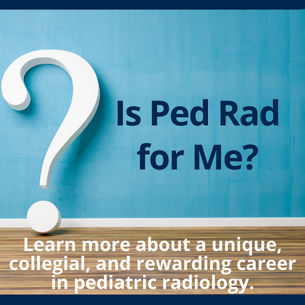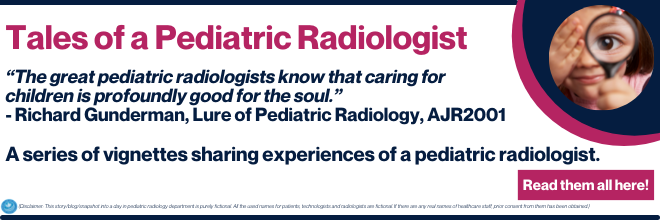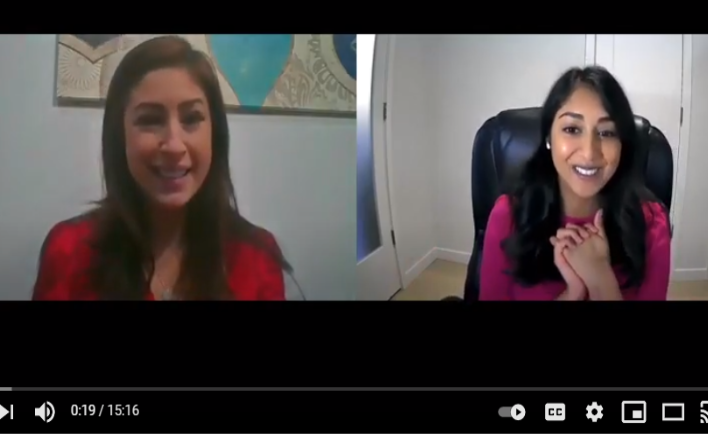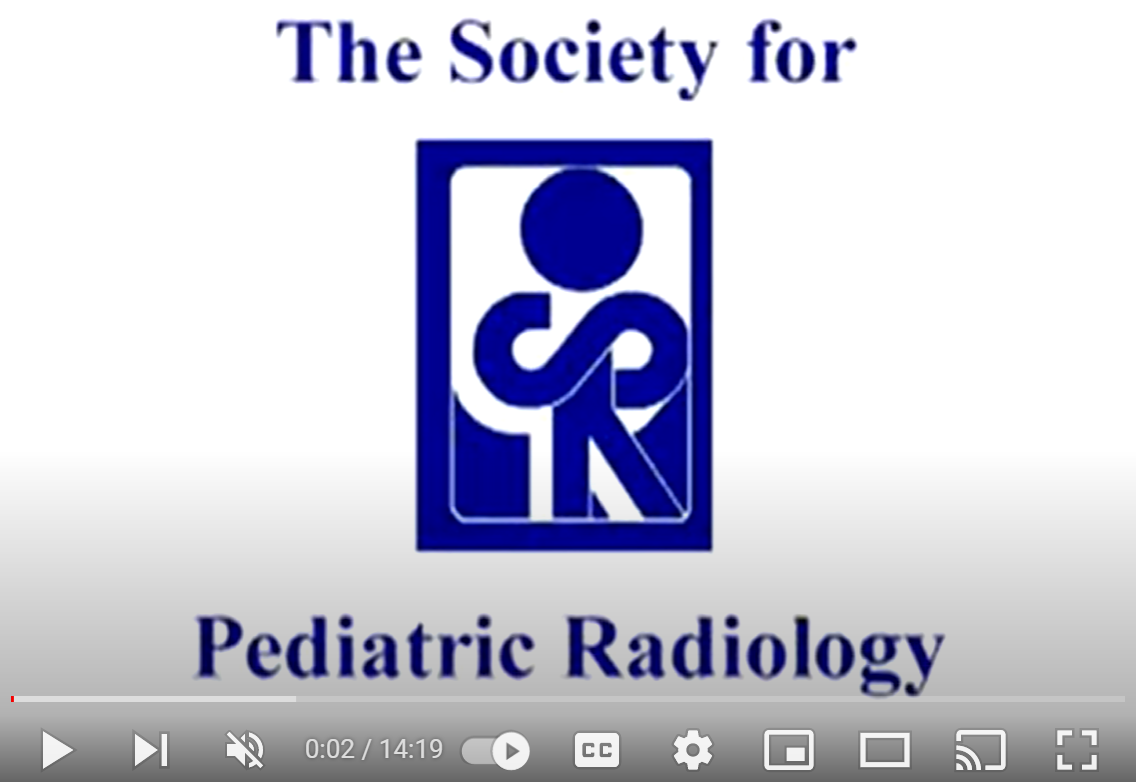Career Hub - Promoting Careers in Pediatric Radiology

Be the change you wish to see in the world! The Career Hub provides resources to help you explore your options within this rewarding field and recruit others so they can also experience the reward of a fulfilling career in pediatric radiology!

NOTICE: Click here to subscribe and receive the job flash emails to remain informed of pediatric radiology opportunities.
Recruiting Toolkit for Pediatric Radiology - New Article Posted

Pediatric Radiology is experiencing a reduction of people pursuing our subspecialty. We believe this is, at least in part, because trainees are not exposed to our work until after the typical fellowship decisions are made.
The ACR Pediatric Radiology Workforce Committee, composed of members who belong both to the SPR and ACR, is working in collaboration with SPR leadership to increase awareness about careers in pediatric radiology with medical students and residents and share the wonders of our field (and our happiness with our choice.)
Myth Busting in Pediatric Radiology
- New Article Alert - Myth Busted! Dispelling Myths Surrounding Pediatric Radiology as a Career
- The August 2024 Slovis Course featured panelists from diverse practices who corrected many "myths" that trainees heard about pediatric radiology regarding salaries, jobs, subspecialization, research, and more! After the webinar, the panelists compiled answers to questions received, further dispelling the "myths." Click here to view the Q&A, and click here to watch the recording.
We know from our own experiences that the choice to pursue pediatric radiology was influenced by inspiring teachers and mentors. We now invite you to be that inspiration and host brief presentations for medical students and residents. Share the joys of our chosen profession!
The Elevator Speech: Top 10 Reasons to go into Pediatric Radiology
- Referring pediatricians and pediatric specialists are remarkably well-adjusted and easy to work with. They get along with children – you’ll fit right in!
- To your colleagues you are a respected member of the team; to the parents, you are a hero.
- Most kids get better and helping them feels great! The impact of what you do each day matters for a lifetime.
- You get to work in a colorful, upbeat environment.
- Generalize or subspecialize in pediatric neuroradiology, interventional, cardiac, musculoskeletal or nuclear medicine.
- The Society for Pediatric Radiology is a strong community with great meetings in exciting locations (such as San Francisco, Miami, Montreal, Tucson, Paris) offering multiple opportunities for continuing education, networking, and fun. You can also participate in the Early Career and Trainee Committee which offers mentoring, lectures, and social events exclusively for pediatric radiology fellows and junior attendings.
- Flexibility: With a fellowship in pediatric radiology you can go into academic, private practice, hybrid practice (community/academic), and teleradiology.
- Portability: There is a vast number of pediatric radiology jobs available all over the country. Take your pick of practice type and location.
- Your pediatric radiology colleagues tend to be smart, friendly, and easy to work with.
- Your job is never boring! You are in a specialized field yet maintain your skills in multiple cutting-edge
modalities including US, CT, MR and Nuclear Medicine.
Presentation Resources
- For Medical Students - Share this video and encourage your faculty to share information about pediatric radiology during the medical student interview process.
- For Residents - Download these PPT slides and associated script to aid in your presentation to residents.
- For Women - This video highlights women leaders in pediatric radiology and was created in celebration of National Women Physicians Day (February 3rd). The day marks Dr. Elizabeth Blackwell's birthday, the first woman to receive a medical degree in the United States in 1849. To learn more about National Women Physicians Day and Dr. Elizabeth Blackwell, click here. The SPR thanks Ms. Eva Hamel for producing the video.

Pediatric Radiology: A Unique Career Choice
Radiologists who have chosen careers in pediatric radiology tend to be happy with their career choice and enthusiastic about their work. Read on for some of the reasons why you might be right for pediatric radiology (and why it might be the ideal career choice for you.)
1. Employment Opportunities:
There is a national shortage of pediatric radiologists. Pediatric radiology jobs are abundantly available in all regions of the United States and even in Canada. Increasing clinical volumes, the expectation that over 1/3 of current practicing pediatric radiologists will retire in the next decade, and increasing demand by physicians for subspecialty reads in non-academic settings have all contributed to the enhanced need for more pediatric radiologists. There will continue to be plenty of job opportunities for the foreseeable future. It is a GREAT time to be a pediatric radiologist looking for a job.
2. High Variety of Job Types:
Demand for pediatric radiologists is high in all types of practice settings (academic, private, hybrid community-academic, and even teleradiology).
Unlike some of the other radiology subspecialties where positions are typically either purely private practice or purely university-based academic jobs, there is a broader spectrum in the practice of pediatric radiology. Many private practice groups hire pediatric radiologists to meet the needs of the children they serve. There are academic pediatric radiology positions in both university hospital pediatric radiology divisions as well as in freestanding Children's Hospitals. There is an enormous need for purely clinical pediatric radiologists, clinician-educators, and researchers. In addition, there are hybrid positions - where private radiology groups at a Children's Hospitals assist in the teaching of residents and in reporting on non-funded research. Furthermore, the demand for pediatric radiologists in teleradiology jobs is also high and allows for the flexibility to work from anywhere in the country.
3. The "General Specialist":
Being able to have an adequate command of knowledge in all the radiology subspecialties is a daunting task for general radiologists. However, many trainees are hesitant to pick a radiology subspecialty for fear of either losing skills outside that area or not being able to participate in modalities or anatomic areas outside their sub-specialty. Pediatric radiologists are very much sub-specialists in the sense that they deal with a very finite, defined, and manageable area of radiology knowledge. At the same time, pediatric radiologists are generalists in the sense that they get to deal with most, if not all, imaging modalities and anatomic areas. Many pediatric radiologists enjoy getting the best of both worlds. Being able to read all of these modalities also affords us a lot of variety in our daily practices, so we never get bored. It is also possible to become a sub-sub-specialist with expertise in a specific area of pediatric radiology, such as pediatric neuroradiology or pediatric interventional radiology. In addition, many private practices and hybrid practices may want a pediatric radiologist who is able to help read adult studies allowing for the ability to keep those skillsets current.
4. Nice People:
The pediatric subspecialties do not have a tendency to attract aggressive, power-hungry people. Most of the people who work in pediatric subspecialties like to work with children and tend to be compassionate, thoughtful, and (honestly) nice. Even most of the surgeons are nice! There also tends to be a very high-level of enthusiasm and dedication at pediatric care facilities. There are fewer issues with turf battles in the pediatric radiology subspecialty areas as compared to their adult counterparts. Many pediatric radiologists find this congenial work atmosphere a major benefit of pediatric radiology.
5. Small and Tight-Knit Community:
Another attraction of pediatric radiology is that the community is relatively small. In 2020, the Society for Pediatric Radiology has ~2000 members, most in North America but also from every corner of the world. You come to know the familiar faces at national meetings and develop many long-lasting friendships. Another benefit of being a smaller radiology organization is that there are ample opportunities to get involved through committee membership, both as trainee members and as active members. Through committee work, pediatric radiologists can help make meaningful and impactful decisions not only for the radiology community for the pediatric community. We also work with other organizations to make health policy recommendations, such as through our work with the American Academy of Pediatrics and the American College of Radiology. Less seriously, but still important: the SPR Annual Meeting features the best dance party in medicine.
6. The Joy of Helping Children:
Probably the most important factor is the satisfaction of working for and helping children. The impact of our work literally lasts a lifetime.
A high percentage of children get better with our help. Pediatric illnesses are not self-induced, and children and families are highly appreciative of your help. In addition, the disease processes that affect children are highly varied and often interesting. Many pediatric conditions are also being recognized as important precursors of adult morbidity and mortality related to health issues such as osteoporosis, diabetes, and obesity.
Conclusion
We hope this information is helpful in your consideration of Pediatric Radiology as a career choice. If you want to know more, have any questions, or want to talk to a pediatric radiologist, please write to us at info@spr.org.
Information on specific pediatric radiology fellowship training programs is available through the ACGME HERE.
New Article Alert - Myth Busted! Dispelling Myths Surrounding Pediatric Radiology as a Career
Other Fun Facts
- Pediatric radiologists provide imaging services for patients with pediatric-related diseases from fetal life to adulthood.
- Pediatric radiologists work with all imaging modalities, including MRI, CT, ultrasound, contrast-enhanced ultrasound and voiding urosonography, PET/CT and PET/MRI, nuclear medicine, radiography, fluoroscopy, and also perform interventional procedures.
- Pediatric radiology is a required element in the training of all diagnostic radiologists and is one of the 10 areas of information upon which candidates are examined for certification by the American Board of Radiology.
- Pediatric Radiology Fellowship programs are generally one year in length. Additional fellowship years are available at some programs for further subspecialization in musculoskeletal radiology, neuroradiology, cardiovascular imaging, and interventional radiology.
- The American Board of Radiology offers a Certificate of Added Qualification in Pediatric Radiology. There are two methods to be eligible for a CAQ in Pediatric Radiology: completing an ACGME-accredited fellowship and the alternate pathway to subspecialty certification. For more info.
- The original pediatric radiology fellowship programs are the oldest fellowships in radiology with several being in existence for over 55 years.
- The Society for Pediatric Radiology is the oldest subspecialty organization in radiology.
We invited SPR members to comment on their careers and share their stories. We hope you enjoy and learn from their journeys.
 Pediatric Radiology in a Minute: The ACR® is pleased to release a new video series — Pediatric Radiology in a Minute.
Pediatric Radiology in a Minute: The ACR® is pleased to release a new video series — Pediatric Radiology in a Minute.
This series features short video testimonials of esteemed pediatric radiologists sharing why they chose careers in
pediatric radiology, what excites them most about the specialty, where they see the future of pediatric radiology going,
and more!
Check out this interview with Dr. Ami Gokli and learn how pediatric radiology is a great career choice with lots of diversity and rewarding daily patient contact. The best colleagues and work environments too!
Enjoy this interview with Dr. Judy Gadde on being a pediatric neuroradiologist as well as her experience being a DO. Judy gives the viewers some excellent advice on navigating radiology residency and fellowship selections and highlights the many characteristics that make pediatric radiology so rewarding.
This video is a compilation of interviews that document what the SPR means to members of the Society and what they enjoy about being pediatric radiologists.
The American College of Radiology® (ACR®) Commission on Pediatric Radiology’s Education and Workforce Committees and the Society for Pediatric Radiology’s (SPR) Physician Resources Committee present an on-demand webinar — Pediatric Radiology: Journey to Imaging Our Future.
Suggested Reading
- New Article Alert - Myth Busted! Dispelling Myths Surrounding Pediatric Radiology as a Career
- Richard Gunderman's 2001 classic article on "The Lure of Pediatric Radiology" and his 2019 article on "Knowing and Being in Pediatric Radiology"
- Peter Strouse's 2019 article on "The Continuous Lure of Pediatric Radiology"

- Tales of a Pediatric Radiologist - Stories by Dr. Govind B. Chavhan and Illustrations by Dr. Ailish Coblentz.
NEW - PRIME Mentoring Program
The PRIME Mentorship Program is committed to the growth and development of our entire SPR membership, from trainees (medical students, residents, and fellows) to senior career-level members.
Duration of PRIME 2025-2026: August 2025 to May 2026 | Interested in being a mentor or mentee? Click here to learn more.




